
S.Warren. Designing organic syntheses
..pdf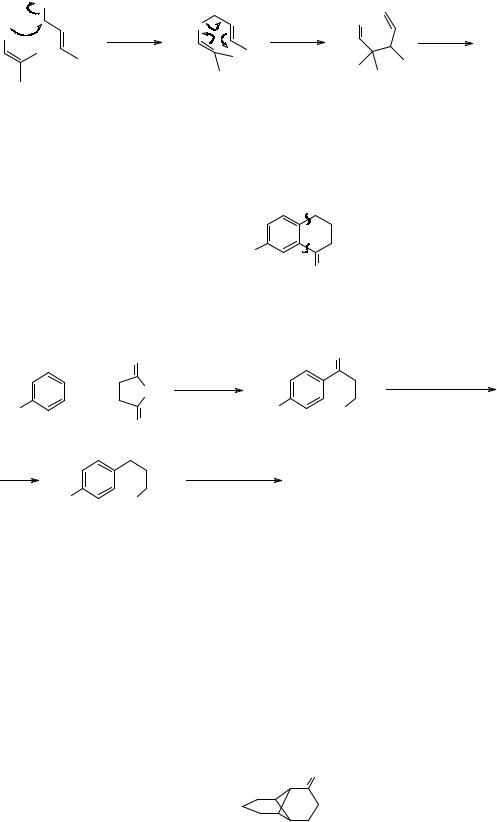
107
327. Since the allyl group has rearranged, it may have added to nitrogen first:
.. |
Br |
+ |
+ |
|
|||
|
Me2N |
Me2N |
|
Me2N |
|
|
H2O |
|
|
|
326 A |
(J. Org. Chem., 1961, 26, 3576).
_______________________________________
328. The strategy of using intramolecular reactions to set up the correct relationship between two groups is of more general importance. We obviously want to disconnect bonds a and b in TM 328 so that we add a four carbon fragment to PhOMe in the synthesis.
|
|
a |
TM 328 |
MeO |
b |
|
||
|
O |
|
|
|
It will be easy to put in bond a because it is para to the MeO group, but bond b might be difficult. The strategy is to put in bond a first and use an intramolecular reaction to force bond b to go in the right place. Succinic anhydride is a convenient four carbon electrophile:
|
O |
|
O |
|
|
|
|
|
|
+ |
AlCl3 |
|
|
Zn - Hg |
O |
|
|
conc. HCl |
|
MeO |
85% |
MeO |
|
|
O |
CO2H |
85% |
||
|
|
|
|
|
|
1. SOCl2 |
TM 328 |
|
|
|
2. |
AlCl3 |
|
|
MeO |
|
|
||
CO2H |
|
|
|
|
|
|
|
|
|
This approach is described in Org. Synth. Coll., 2, 81, 499, 571, and these particular compounds and reactions in J. Chem. Soc., 1934, 1950; J. Amer. Chem. Soc., 1936, 58, 1438, 2314; 1942, 64, 928. The final cyclisation can be done directly on the acid with anhydrous HF in 93% yield.
_______________________________________
(b) POLYCYCLIC COMPOUNDS – THE COMMON ATOM APPROACH
329. Another strategic device applies specifically to polycyclic compounds. In the interests of simplification we want to remove some of the rings and give an intermediate with a familiar ring structure. We can do this by the “common atom’ approach. In TM 329, mark all the carbon atoms which belong to more than one ring – the “common atoms”.
O
TM 329
_______________________________________
330.
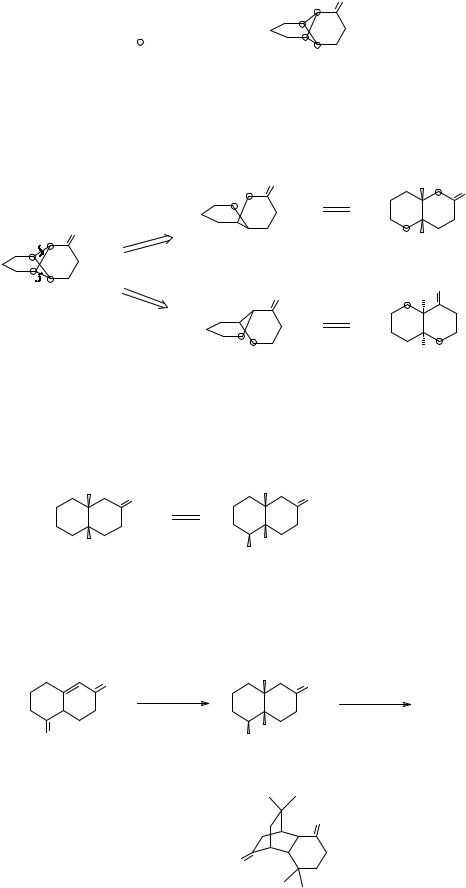
108
O
= common atoms
Now disconnect any bond joining two common atoms and see if there is a good starting material.
_______________________________________
331. Because of the symmetry of TM 329 there are only two different disconnections of bonds between two common atoms.
|
|
|
O |
H |
O |
|
|
|
|
|
|
a |
O |
a |
|
H |
A |
|
|
||||
b |
|
b |
O |
H |
O |
|
|
|
|
H |
B |
One of the marked atoms in each intermediate will have to be + and one -. Can you see a good starting material here?
_______________________________________
332. For A we can put the – next to the carbonyl group and provide a leaving group for the + :
H |
- O |
H |
O |
+ H |
|
X H |
X = Br , OTs etc. |
|
332 A |
||
|
|
|
If you don’t see why the stereochemistry should be as I have drawn it, I suggest you make a model of 332A and discover for yourself. There is a simple synthesis of 332A (X = OTs) from the Robinson annelation (frame 117) product 332B.
|
O |
H |
|
O |
|
|
|
base |
|
|
TM 329 |
|
|
steps |
O |
332 B |
TsO H |
|
|
Using the common atom approach, design a synthesis of TM 332.
O
TM 332 |
O |
|
_______________________________________
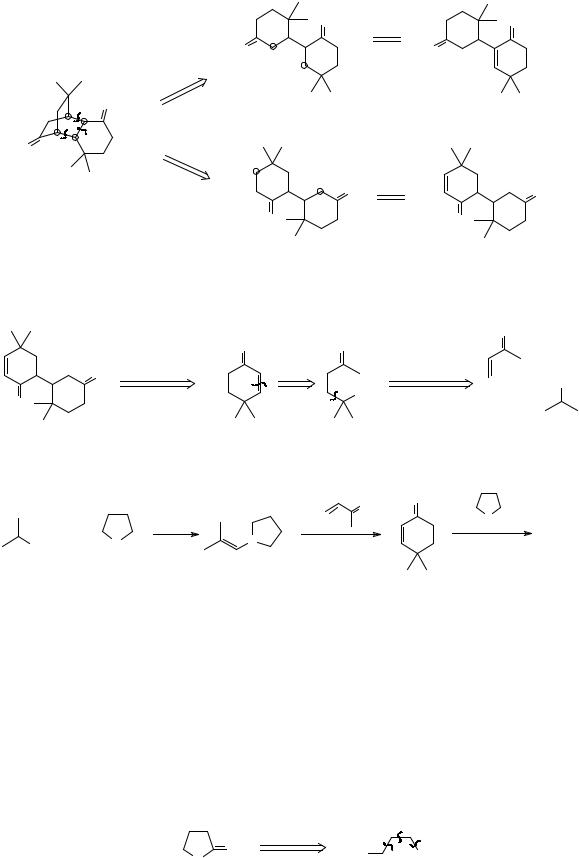
109
333. Analysis: Marking the common atoms we find there are three possible disconnections of bonds between them, but only a or c give us simpler precursors. Both also are ‘logical’ in that we can immediately write reagents for the synthons.
|
|
|
|
O |
|
|
O |
|
|
|
O |
- |
|
O |
|
|
|
|
|
|
|
|
|
|
a |
|
|
+ |
|
|
A |
|
|
|
|
|
|
||
|
c O |
|
|
|
|
|
|
|
b |
|
|
|
|
|
|
O |
a |
c |
|
|
|
|
|
|
|
|
|
|
|
||
|
|
|
+ |
|
|
|
|
|
|
|
|
|
|
|
|
|
|
|
|
- |
O |
|
O |
|
|
|
|
|
|
||
|
|
|
|
O |
|
O |
B |
|
|
|
|
|
|
|
Both A and B are 1,5-dicarbonyl compounds, but only B can be disconnected in the usual way. The result is two molecules of an α,β-unsaturated ketone and we can continue the analysis:
|
|
|
O |
|
|
|
O |
O |
|
|
|
O |
1,5 - di CO |
|
1,5 - di CO |
|
|
2 |
CHO |
+ |
CHO |
||
|
|||||
|
|
|
|
||
O |
|
|
|
|
|
B |
|
|
|
|
Synthesis: Carried out by Lewis (J. Chem. Soc. (C), 1971, 753) using enamines for each step:
|
|
|
|
|
O |
O |
|
|
|
|
+ |
|
1. |
|
|
||
|
|
|
|
N |
|
|||
|
|
H |
|
|
|
|
||
|
+ |
N |
+ |
|
H |
TM 332 |
||
CHO |
N |
/ H2O |
2. HOAc |
|||||
|
|
|||||||
|
|
H |
|
2. H |
|
|
_______________________________________
3. CONSIDERING ALL POSSIBLE DISCONNECTIONS
334. Apart from aiming for a convergent synthesis or using the two strategic devices we’ve just seen, special tricks in strategic planning are unimportant. The main thing is to find the shortest route with the best individual steps. To do this we ought to consider all possible disconnections even those which don’t look very promising initially.
As an example, let’s analyse the synthesis of γ-lactones (e.g. TM 334) and see how we may choose one of a number of strategies depending on the structure of the target molecule. We’ll consider in turn each of the three C-C bond disconnections. The one with the most appeal is probably b: complete the analysis for this approach.
|
FGI |
a |
b |
|
c |
||
TM 332 |
O |
HO |
CO2H |
O |
_______________________________________
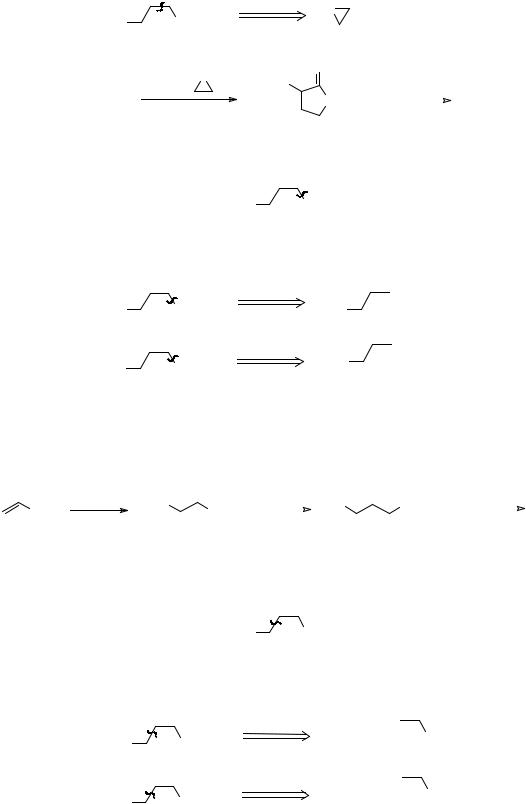
110
335. Analysis: This is the approach to 1,4-dioxygenated skeletons we used in frames 171-186. We need an ‘illogical’ electrophile – in this case an epoxide:
|
b |
|
|
- |
|
|
O |
+ |
|
HO |
CO2H |
|
CH2CO2H |
|
|
|
|
Synthesis: Protection and activation as usual:
- |
O |
O |
- |
|
|
|
EtO2C |
/ H2O |
|||||
|
||||||
EtO , |
|
|
1. HO |
|||
CH2(CO2Et)2 |
|
O |
|
|
TM 334 |
|
|
|
|
||||
|
|
|
2. H+, heat |
|||
_______________________________________
336. What possible synthons might we need for disconnection c:
c HO CO2H
_______________________________________
337. We can choose either polarity:
|
i |
|
+ |
HO |
CO2H |
HO |
-CO2H |
|
|
i i |
- |
|
|
+CO2H |
|
HO |
CO2H |
HO |
|
|
|
Both are possible but we are more used to (i) since we can use a Michael acceptor and cyanide ion for the two synthons. How would you actually do a synthesis this way?
_______________________________________
338.
CN- |
|
NaBH4 |
|
|
1. HO-/ H2O |
|
NC |
CHO |
|
NC |
OH |
|
TM 334 |
CHO |
|
|
|
2. H+ |
|
|
|
|
|
|
|
|
_______________________________________
339. Now analyse the last disconnection, a, in the same way, writing the synthons and considering possible reagents for them.
a
HO CO2H
_______________________________________
340. Again, either polarity is possible:
|
i |
+ |
+ |
- |
|
CO2H |
|||
HO |
CO2H |
HOCH2 |
||
|
|
|
||
|
i i |
- |
|
+ |
|
+ |
CO2H |
||
|
|
|||
HO |
CO2H |
HOCH2 |
||
|
|
|
Route (ii) could use a Michael acceptor together with a suitable one carbon nucleophile such as MeOCH2MgCl. Route (i) could have formaldehyde as the electrophile and a suitably protected and activated derivative for the nucleophile such as ...
_______________________________________
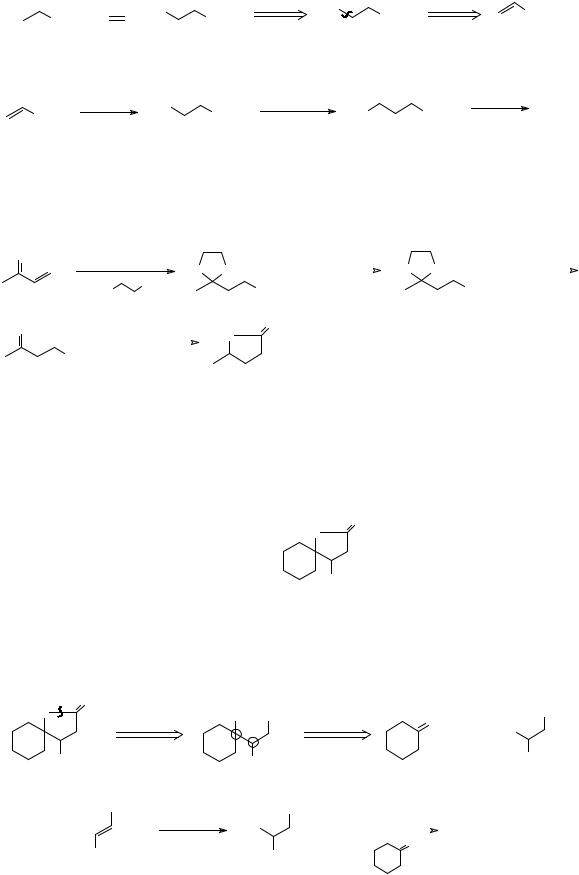
111
341. By analogy with the Reformatsky reaction, the zinc derivative of a β-bromoester would do:
- |
CO2H |
BrZn |
CO2Et |
Br |
|
CO2Et |
|
CO2Et |
|
|
|
|
|
|
|||||
|
|
|
|
|
|
|
|
|
|
So the synthesis becomes: |
|
|
|
|
|
|
|||
|
|
HBr |
Br |
|
1. Zn |
|
|
|
etc. |
|
CO |
CO2Et |
|
HO |
|
CO2Et |
TM 334 |
||
|
Et |
|
2. CH2O |
|
|
||||
|
2 |
|
|
|
|
|
|
|
|
_______________________________________
342. Each of these approaches may be the best for any given lactone: the one in the last frame for example would allow you to use any Michael acceptor and any aldehyde.
Which strategy is being followed here?
O |
1. HBr |
|
|
1. Mg |
|
O O |
H+/ H2O |
||||
|
|
|
O |
O |
|
|
|
|
|
||
|
2. HO |
|
2. ClCO2Me |
|
|
||||||
|
OH |
Br |
|
CO2Me |
|||||||
O |
|
|
NaBH4 |
|
O |
|
|
|
|
|
|
|
|
O |
|
|
|
|
|
||||
|
CO2Me |
|
|
|
|
|
|
|
|
|
|
_______________________________________ |
|
|
|
|
|||||||
343. One |
we hadn’t |
explored in |
detail: it’s |
strategy c |
(ii) outlined in frame 337 with |
||||||
ClCO2Me for +CO2H and the protected β-bromoketone for MeCH(OH)CH2CH2-.
_______________________________________
344. Now try this one for yourself: Suggest which strategy is most suitable for TM 344.
O
O
TM 344
CO2Et
_______________________________________
345. Analysis: Opening up the ring to see the true problem & using our branch point guide we really want to disconnect the bond between the two ringed atoms so that strategy a (i), frame 340 is best.
O |
O |
|
|
|
CO2H |
FGI |
OH CO2H |
O |
|
||
|
+ |
BrZn |
|||
|
|
|
|
||
|
|
|
|
|
|
|
CO2Et |
CO2Et |
|
|
CO2Et |
Synthesis: Putting R = Et, this is easy:
CO2Et |
CO2Et |
1. Zn |
||
HBr |
Br |
|
||
|
|
|
TM 344 |
|
|
|
|
|
|
CO2Et |
2. |
O |
||
CO2Et |
|
|
||
_______________________________________
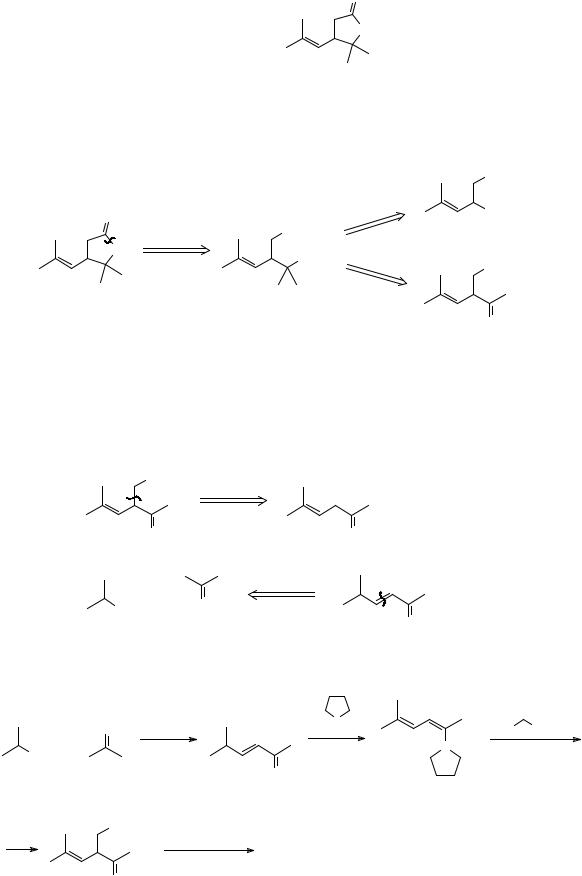
112
346. now try your hand at this more challenging example.
O
O
TM 346
_______________________________________
347. Here is one possible solution:
Analysis: As usual, we open the ring first: the tertiary alcohol can be made by adding one or two mols of MeMgI.
|
|
CO2R |
|
O |
|
CO2R |
A |
CO2R |
|
||
FGI |
or |
|
|
O |
|
|
|
OH |
|
|
|
|
CO2R |
|
|
|
|
|
|
|
|
O |
B |
A is no good because MeMgI would have to attack the more crowded ester first. So, how do we make B?
_______________________________________
348. Analysis: The most suitable disconnection follows the strategy we originally used (b, in frames 335, and 171-175). But can we make the right enamine from the unsaturated ketone, and does it alkylate in the right place? It turns out that it can and does.
CO2R
+ Br CO2R
CO2R
O O A
+
CHO O B O
Either 348A or B gives the right enamine, but B is an α,β-unsaturated ketone and so easier to disconnect.
Synthesis: (Bull. Soc.Chim. France, 1955, 1311; 1962, 2243).
|
O |
NaOH |
N |
Br CO 2 Me |
+ |
H |
|||
|
I2 |
H+ |
N |
|
CHO |
|
|||
|
|
68% |
O |
|
CO2Me
MeMgI
TM 346
O
_______________________________________
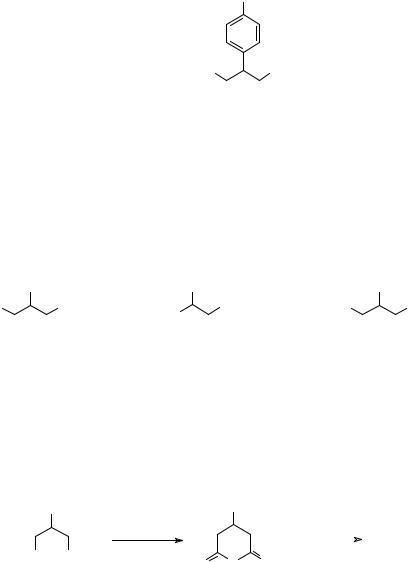
113
4.ALTERNATIVE FGIs BEFORE DISCONNECTION The Cost of a Synthesis
349. The γ-lactone problem is made easier because the FGs are all based on oxygen. The molecule can therefore be disconnected without FGI except for oxidation or reduction. Let’s now look at the synthesis of a molecule with a ‘difficult’ FG: the muscle relaxant ‘baclofen’ TM 349. What is the difficult FG?
Cl
TM 349 |
H2N |
CO2H |
_______________________________________
350. The amino group.
What FGI’s on TM 349 give us molecules we can disconnect? There are in fact three, but you may not see one of them.
_______________________________________
351. We have meet NO2 and CN before, but a primary amine can also be made from an amide by the Hofmann degradation (see Norman p.446-7 or Tedder, vol.2, p.281-2).
|
Ar |
Ar |
|
Ar |
O2N |
CO2H |
CO2H |
H2NCO |
CO2H |
|
|
NC |
|
|
|
351 A |
351 B |
|
351 C |
To make 351C we need to convert a dicarboxylic acid into its half amide. How might we do this?
_______________________________________
352. Since the molecule is symmetrical, attack of ammonia on the cyclic anhydride will do it:
|
Ar |
|
Ar |
|
||
|
|
Ac2O |
|
NH3 |
351 C |
|
HO2C |
CO2H |
O |
O O |
|||
|
||||||
|
|
|
||||
|
352 A |
|
|
|
|
|
So we really need to disconnect 351A and B and 352A. Analyse possible disconnections of these three on the same chart since they will have several starting materials in common.
_______________________________________
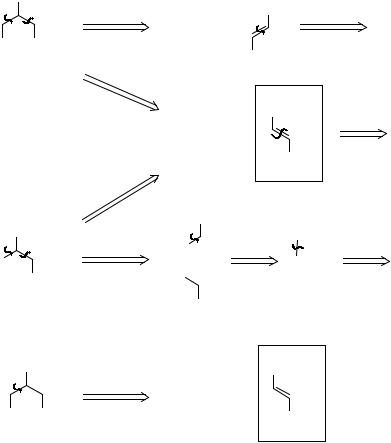
114
353. Analysis: All by familiar disconnections.
|
Ar |
|
- |
malonate |
|
|
|
|
|
||
a |
b |
b |
CH2CO2H |
Ar |
|
|
|
||||
|
|
|
|||
O2N |
|
CO2H |
|
|
+ |
|
|
|
|
|
NO2 |
||
351 A |
|
|
|
|||
|
a |
|
|
|||
|
|
|
|
|
|
|
|
|
|
|
|
|
A |
|
|
|
|
MeNO2 |
+ |
Ar |
|
|
|
|
|
||
|
|
|
|
-CN |
+ |
CO2H |
|
|
|
a |
|
|
|
|
Ar |
|
Ar |
|
|
|
a |
|
NC |
|
Ar |
||
|
b |
b |
|
|
||
|
|
|
|
|||
NC |
|
|
|
+ |
|
CH2Cl |
|
|
CO2H |
|
Br |
|
|
351 B |
|
CO2H |
|
|||
|
|
Ar |
|
|
|
A |
|
|
|
-CH2CO2H + |
Ar |
||
|
|
CO2H |
|
|
||
HO2C |
|
malonate |
|
CO2H |
||
|
|
352 A |
|
|
|
|
ArCHO + MeNO2
ArCHO + -CH2CO2H
malonate
ArH + CH2O
All these routes use known reactions and are about the same length. Do you notice that no less than three have the unsaturated acid 353A as an intermediate. If we need to try out new reactions it is best to choose a route with a common intermediate (353A here) so that if one route fails we can use the same intermediate for another. We can then choose between the three routes on cost. The 1977 prices of the starting materials are:
p-chlorobenzaldehyde |
&9.80/500g |
diethyl malonate |
&2.80/500g |
sodium cyanide |
&2.07/500g |
nitromethane |
&6.80/kg |
Assume solvents etc., cost the same for each route. Which route will you try first?
_______________________________________
354. Cost per mole is the relevant figure: p-chlorobenzaldehyde, MW 140.5, costs &2.75 per mole. Diethylmalonate, MW 160, costs &0,89 per mole. Sodium cyanide, MW 49, costs &0.20 per mole. Nitromethane, MW 61, costs &0.41 per mole.
353A is common to all the routes we are considering but it is obviously cheaper to use a mole of cyanide or nitromethane rather than another mole of malonate. In fact, though, these contribute relatively little to the cost, the main part being p-chlorobenzaldehyde. So, use whichever route you like!
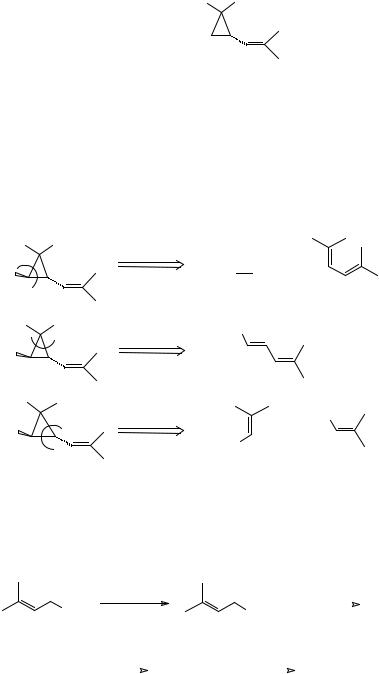
115
_______________________________________
5. FEATURES WHICH DOMINATE STRATEGY
355. Chrysanthemic acid (TM 355) is an important constituent of pyrethrins – naturally occurring insecticides which are virtually harmless to mammals. What feature of this molecule will dominate our strategic thinking?
HO2C
TM 355
_______________________________________
356.You might reasonably have said stereochemistry, but the best answer is the three membered ring. Which three ‘carbene’ disconnections might we consider? (See frames 276-288 if you’ve forgotten all this!).
_______________________________________
357.We disconnect two bonds at once to give us a ‘carbene’ and an olefin:
|
a |
.. |
+ |
|
HO2C |
|
|
||
|
HO2C CH |
|
|
|
a |
|
|
|
A |
b |
b |
HO2C |
+ |
.. |
HO2C |
|
|
CMe2 |
|
|
|
B |
|
|
|
|
|
.. |
|
c |
c |
|
HC |
|
|
+ |
|
||
HO2C |
|
HO2C |
|
|
|
|
|
|
How would you actually carry out a and what do you think of the prospects?
_______________________________________
358. Analysis: The carbene synthon is easy: it can be ethyl diazoacetate N2CHCO2Et. The diene can be made by the Wittig reaction from a familiar allylic bromide (TM 31).
Synthesis:
|
Ph3P |
|
+ |
|
BuLi |
A |
Br |
|
|
PPh3 |
|
acetone |
|
TM 31 |
|
|
|
|
|
|
NH2CH2CO2Et |
HNO2 |
N2CHCO2Et |
A |
|
TM 355 ? |
|
|
|
|
|
Comments: The diene A is symmetrical so it doesn’t matter which double bond is attacked by the carbene. On the other hand, it may be difficult to stop carbene addition to the second double bond. The only control over the stereochemistry will be that the trans compound we want is more stable. Japanese chemists have recently synthesised optically active trans chrysanthemic acid by this route (Tetrahedron Letters, 1977, 2599).
It turns out thatthe less stable cis can be converted into the trans by treating the ethyl ester with EtO- in EtOH. (ibid., 1976, 2441).
_______________________________________
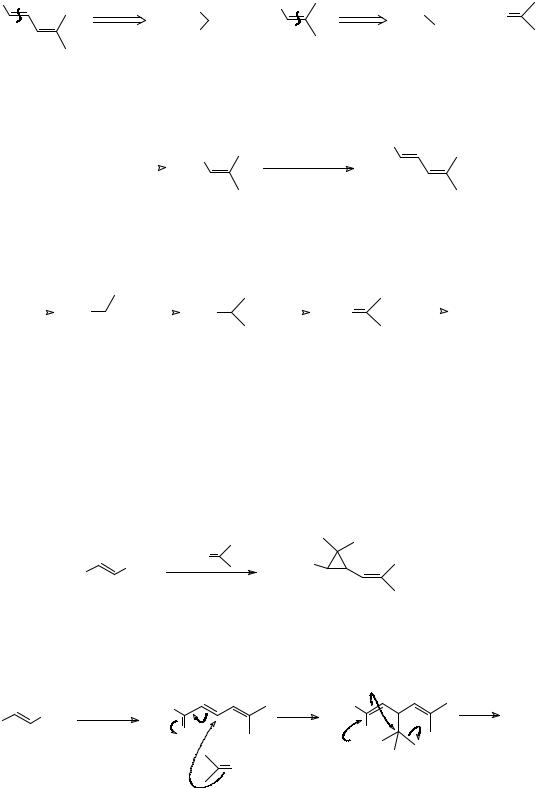
116
359.Now consider strategy b. How would you make the diene acid B, what reagent would you use for the carbene synthon, and how do you rate the chances of this route?
_______________________________________
360.Analysis: The normal approach to the diene looks all right:
HO2C |
HO2C |
OHC |
OHC |
+ O |
|
+ |
|
|
|
|
HO2C |
|
|
CH3 |
|
|
|
|
The carbene synthon might be difficult, but since the olefin is conjugated with a carbonyl group we could try a sulphur ylid as a nucleophilic carbene equivalent (as in frame 283).
Synthesis: The diene could be made by this route:
|
1. R2NH , H+ |
OHC |
CH2(CO2H)2 |
HO2C |
MeCHO |
|
|||
2. acetone |
|
piperidine |
B |
|
|
|
One example of a suitable suitable sulphur ylid is the one below (C) (Corey, Tetrahedron Letters, 1967, 2325) and ylids of this sort have been added to α,β-unsaturated ketones (Tetrahedron Letters, 1966, 3181):
|
EtI |
+ |
base |
+ |
base |
B |
TM 355 ? |
|
Ph2S |
|
Ph2S |
|
Ph2S |
|
Ph2S |
|
|
|
MeI |
|
(ester) |
|||||
|
|
|
|
|
C |
(as the ester) |
||
|
|
|
|
|
|
|
|
|
Comments: We have to explore new chemistry here and the main problem does seem to be getting the right combination of diene and carbene reagent. Perhaps not such a good route.
_______________________________________
361. However, things don’t always conspire against us in synthesis! In 1976 Krief (Tetrahedron Letters, 1976, 3511) carried out an innocent-looking Wittig reaction which might reasonably have given the ester of diene 360B. Instead it gave the ester of TM 355 in good yield! Can you explain what has happened?
CHO |
Ph3P |
MeO2C |
MeO2C |
|
361 A |
_______________________________________
362. First the normal Wittig reaction, and then a second mol of Wittig reagent must be behaving as a carbene equivalent, just as we hoped the sulphur ylid would.
|
CHO |
MeO |
MeO |
|
361 A |
MeO2C |
|
|
|
||
Wittig |
O |
O |
|
|
|
|
|
|
- |
PPh |
|
|
|
|
|
+ |
3 |
PPh3
So this strategy turns out to be all right too. Now how might you realise strategy c in frame 357?
